The M32 MGL with the US Marines. (Photo USMC)
By Julio Montes
Last April 2007, Imbel leader General Cássio Cunha signed an MoU (Memorandum of Understanding) with Dr. Fritz Visser, CEO from Rippel Effect Weapon Systems (Pty) Limited, for the two companies to cooperate with the production of the highly successful Multiple Grenade Launcher (MGL) in Brazil. The MGL is designed to be simple, rugged and reliable, and has been well received by military establishments in South America. Rippel Effect (formerly Milkor Marketing) is a member of the Ngwane Defense Group of South Africa, and is the prime contractor for the 40mm multi-shot grenade launcher systems to more than 30 countries worldwide. It is reported that the company has sold more than 6,000 grenade launchers to various international clients within the last 18 months. Some 30,000 weapons have been produced, and the company recently concluded a MoU with Raas Intratech Pvt Ltd. of India as well.
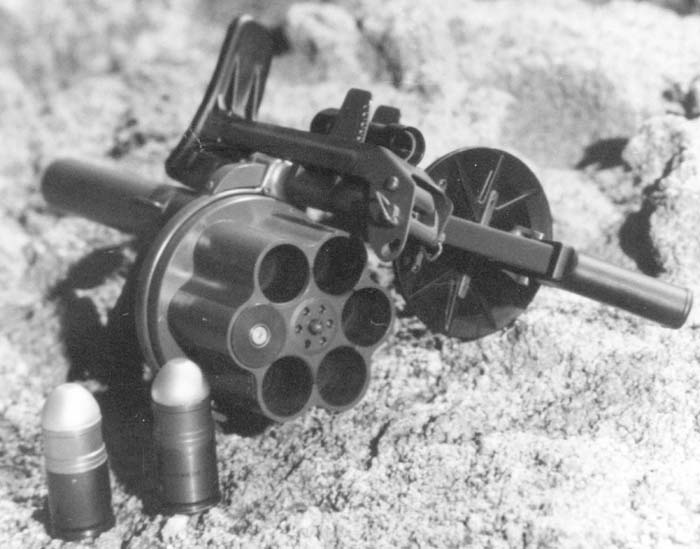
In Brazil, André “MGL” Louw, from Rippel Effect Weapon Systems, allows us a look to the XRGL40, a redesigned MGL capable of accepting all the available 40mm low-velocity grenades, and most interesting equipped with a digital laser rangefinder, which basically allows precise shooting to the maximum range of the weapon (up to 1,000 meters). The XRGL40 uses the same semiautomatic revolver system with a drum magazine holding 6 grenades. The MGL traces its lineage to 1981, as one of the many innovations of Armscor during the counterinsurgency war in South Africa. The first production MGLs came out in 1983 under the designation of Y2. Other countries adopted the weapon under the name of MGL L6. Louw tells us that between other things, the XRGL40 allows for the use of longer grenades, providing for additional range and more lethal loads. The digital sight replaces the Trijicon Occluded Eye Gunsight (OEG), which had a 375 meter range.
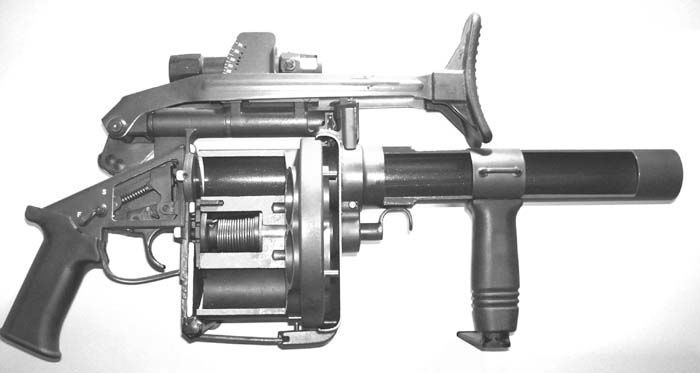
The MGL perhaps traces its inspiration to the Hawk Engineering MM-1, a weapon of similar concept, with a drum magazine and revolver style operation, which was designed in the US at the end of the 1970s. The MM-1 was a simple multi-shot launcher, holding 12 ready grenades, and operated by a spring system. A few were supplied to the Long Range Reconnaissance Patrols (PRALs) in El Salvador, and another handful went to support companies to be used “ala Mk19 style” as a support weapon since, in theory, the launcher could be fired at a 144 rpm rate – but a more realistic 30 rpm was the norm – to a 350m range. The MM-1 had a hefty weight of 5.7 kg (12.57 lbs.) empty and 10 kg (22.05 lbs.) with all 12 grenades.
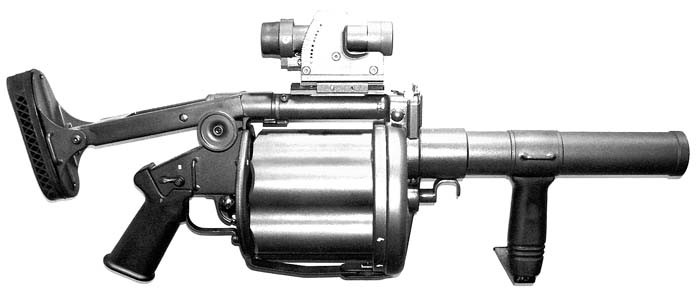
In contrast, the South African MGL has a 356mm (14.02 in.) length barrel, and a total length of 566mm (22.28 in.) with the butt retracted and 788mm (31.02 in.) with the stock extended. Its weight is 5.3 kg, (11.68 lbs.) and features a rotating drum style cylinder with 6 chambers.
MGL
In 1995, this author was the first one to publicly notice the Armscor MGL L6 (MGL Y2) in the hands of Mexican units. After the report was published with Jane’s in London, the Mexican newspaper La Jornada made its own inquiries, and – taking someone else’s assessment – alleged that the weapon was evidence that the military had violated the UN imposed arms embargo against South Africa. It was claimed that the weapons were acquired long before being operational in September 1994, and before the embargo was lifted in May 1994 – this assessment as a result of the sophistication in the operations of the MGL. The Mexican National Defense Secretariat (reportedly, and apparently, backed by the U.S. DoS) immediately denied the existence of the launcher in the ranks, which clashed badly with the truth, and the pictures. This only placed doubts on whether the embargo had indeed been violated.
Although being able to fire with accuracy requires some training, any soldier can easily operate the weapon. The MGL is a very simple, rugged and unsophisticated weapon that operates much like a shotgun, and sports a revolver-style magazine. The cylinder is spring-loaded and rotates automatically after each shot – again much like a revolver. The drum magazine is unlocked and pivoted to load 6 grenades, which could be launched to some 350 meters. It comes with an adjustable folding metal stock, and an IR-capable OEG red dot sight for precision fire up to 375 meters. In America, the USMC has taken delivery of the MGL as the M32, and it is also used by the military in Mexico, Chile, Colombia, Ecuador, Peru, and now Brazil. The Salvadorian PRALs could also do with a few MGLs to replace their obsolete MM-1s.

The original model has evolved in a family of weapons. Richard Potgieter, from Milkor, gave us a look into several of these models while in Brazil. The MGL Mk1, with an aluminum frame, came to the market in 1996. In 2004, the company presented the Mk-1S, with a stainless steel frame, and incorporating several Picatinny rails, and the Mk-1L, with a 140mm (5.51 in.) long cylinder with the capacity to fire a larger menu of grenades, including tear gas canisters. The information available indicates that the Mark-1S variant is a 3rd generation model with a 105mm (4.13 in.) chamber, and meets all NATO standards. The Mark-1S is an area type weapon with the capacity to deliver 40mm grenades to an efficient range of 375m at a rate of 6 rounds in three minutes. The chamber space allows accommodation of tear gas, rubber baton, and flash-bang grenades in addition to combat types. It functions under the same semiautomatic operations, using a spring revolver system, with a practical rate of fire of 24 rpm, and a theoretical rate of 120 rpm. It measures 740mm (29.13 in.) with butt extended, and 640mm (25.2 in.) with stock retracted. Its empty weight is 6.3 kg (13.89 lbs.) and it comes with the standard OEG sight. The Mark- 1L has been designed with a longer 140mm (5.51 in.) chamber space cylinder that allows the use of “smokeless” grenades in addition to those used in the Mk-1S. Its total length is 775mm (30.51 in.) with extended stock, and 680mm (26.77 in.) with it retracted, weighting 6.8 kg (14.99 lbs) empty. The MRGL is a multipurpose tactical weapon with interchangeable 105mm (4.13 in.) and 140mm (5.51 in.) drums, and having the standard 375 meters range with low velocity grenades, and up to 1,000 meters with medium velocity models.
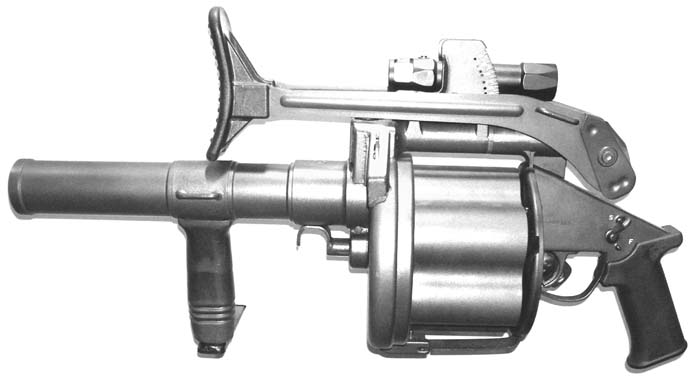
A product improvement appeared in 2005 under the designation of MGL-140, with retail cost of $6,000 per unit. In October of that year, Milkor USA received an initial contract from the USMC for 9,000 units; these would be somewhat modified and supplied as the M32 MGL. This new variant has a minimum range of 30 meters and a maximum of 400 meters, and it is capable of firing the new Hellhound Hyper Lethal grenade. It comes with a “crane-style Vltor Modstock,” a “Sopmod Tan” color and a “weighted twostage trigger.” For now, the MGL is distributed among various USMC battalions in small numbers for field-testing and familiarization, with the first examples reaching combat units in Iraq in 2006. Milkor USA also offers the MGL-140 and the MGL-105 (MGL Mark-S), and all of them, including the M32, come with a M1A2 reflex sight standard (power provided by a AAA battery, for a 500 hours use).
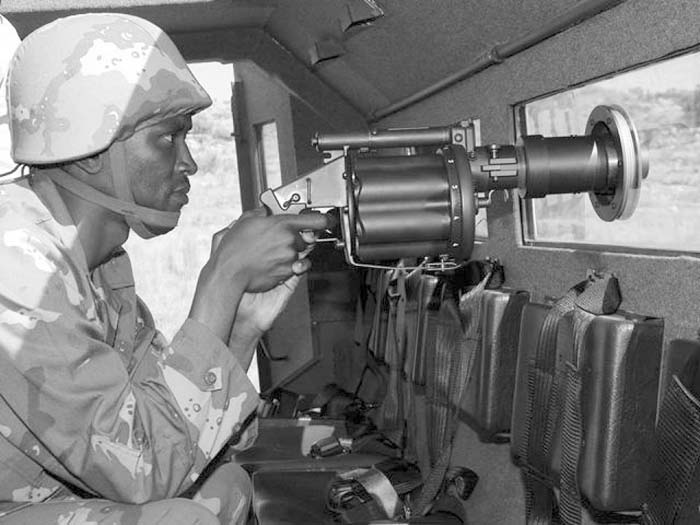
The South African MGL simplicity, reliability, and effectiveness in harsh environments ranging from jungles to deserts have made it a favorite of sophisticated and not-so sophisticated armies and security forces alike.

| This article first appeared in Small Arms Review V11N5 (February 2008) |











